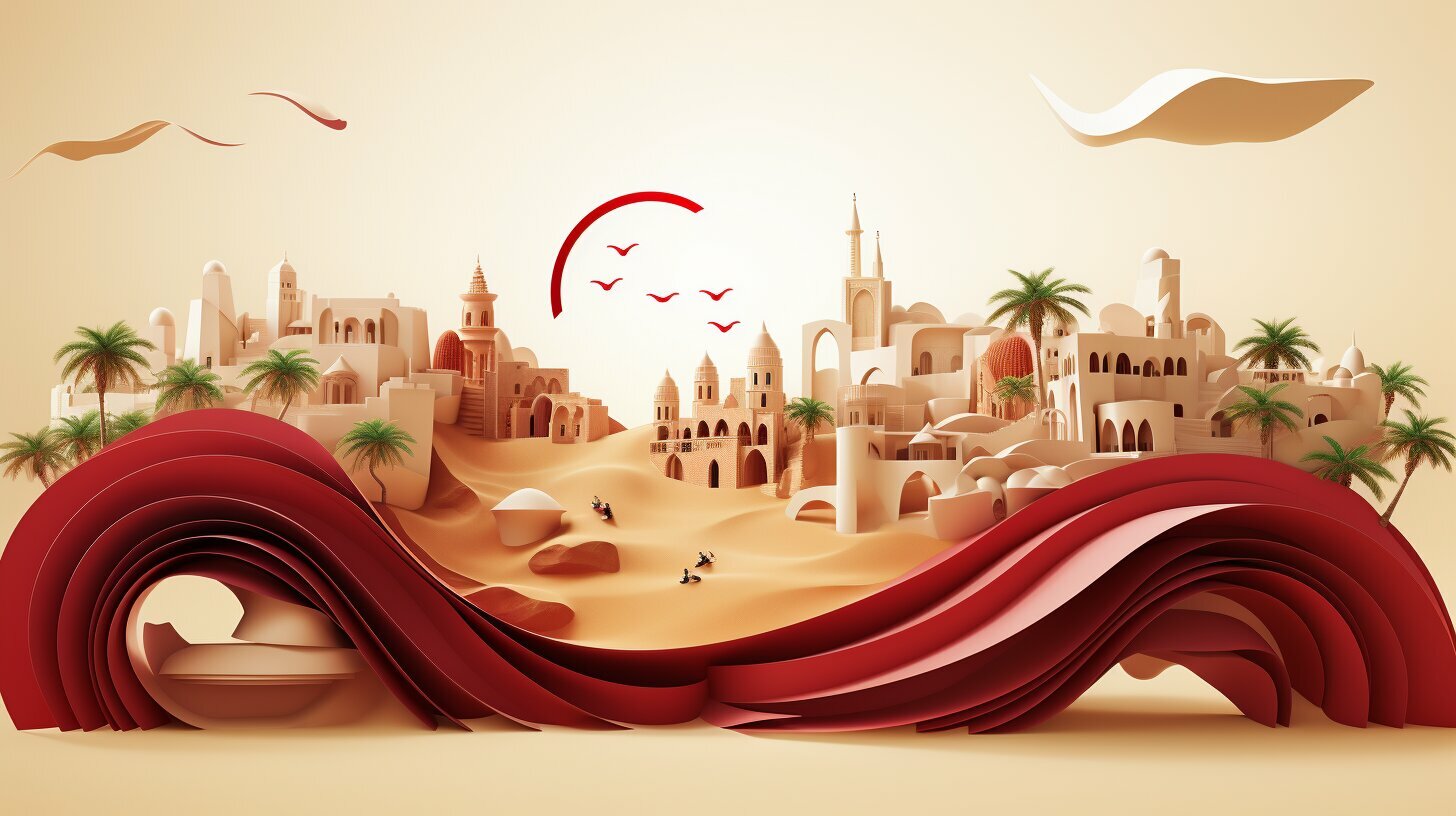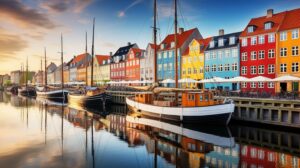Qatar, officially known as the State of Qatar, is a country located in West Asia. It occupies a peninsula on the northeastern coast of the Arabian Peninsula in the Middle East. Qatar shares its only land border with Saudi Arabia to the south, while the rest of its territory is surrounded by the Persian Gulf. The capital and largest city of Qatar is Doha. The country has a population of around 3 million people, with a majority of them being expatriates. The official language is Arabic, but English is also commonly spoken. Qatar is a hereditary monarchy ruled by the House of Thani, and the current Emir is Tamim bin Hamad Al Thani. The country is known for its abundant natural gas and oil reserves, making it one of the world’s wealthiest nations.
Key Takeaways:
- Qatar is located in West Asia, on the northeastern coast of the Arabian Peninsula.
- It shares its only land border with Saudi Arabia and is surrounded by the Persian Gulf.
- The capital and largest city of Qatar is Doha.
- Qatar has a population of around 3 million people, with a majority of them being expatriates.
- The official language is Arabic, but English is also commonly spoken.
- Qatar is a hereditary monarchy ruled by the House of Thani.
- The country is known for its abundant natural gas and oil reserves, making it one of the world’s wealthiest nations.
Qatar’s Geographic Position
Qatar occupies a peninsula on the northeastern coast of the Arabian Peninsula in the Middle East. Nestled in the heart of the Arabian Gulf, this small but influential country is known for its strategic location and rich cultural heritage. Surrounded by the Persian Gulf, Qatar is uniquely positioned, making it a significant player in regional politics, trade, and investments.
With Saudi Arabia as its only land neighbor to the south, Qatar’s geographic position has shaped its relationships with neighboring countries. The shared border with Saudi Arabia has both political and economic implications, influencing trade routes, transportation networks, and regional cooperation initiatives. This close proximity to a regional powerhouse has had a profound impact on Qatar’s development and global influence.
As a coastal nation, Qatar’s natural surroundings play a crucial role in its identity and economic growth. The Persian Gulf not only provides Qatar with abundant natural resources, including oil and gas reserves, but it also serves as a gateway to global trade. The strategic location along major shipping routes has transformed Qatar into a regional hub for commerce and international relations, attracting investments from around the world.
In summary, Qatar’s geographic position on the Arabian Peninsula, with its border shared with Saudi Arabia and its access to the Persian Gulf, has shaped its history, culture, and economic trajectory. This unique location has positioned Qatar as a key player in the Middle East, with considerable influence on regional affairs and global trade.
Table: Qatar’s Borders
| Neighbor | Type of Border |
|---|---|
| Saudi Arabia | Land Border |
Qatar’s Borders
Qatar shares its only land border with Saudi Arabia to the south. Located on the northeastern coast of the Arabian Peninsula, Qatar is surrounded by the Persian Gulf, offering breathtaking views of its azure waters. The country’s strategic location in West Asia makes it a significant player in the region’s geopolitics.
Qatar’s border with Saudi Arabia stretches for approximately 87 kilometers (54 miles), creating a unique connection between the two countries. This border is marked by a fence and guarded checkpoints, enabling smooth transit between Qatar and its neighboring nation.
As a peninsula, Qatar is flanked by the Persian Gulf on its remaining sides. Its stunning coastline attracts tourists and locals alike, with pristine beaches and an array of marine life. The country’s coastal areas provide opportunities for water sports, fishing, and recreational activities, contributing to Qatar’s vibrant tourism industry.
Border Crossing Points
| Border Crossing | Location | Operational Hours |
|---|---|---|
| Abu Samra Border Crossing | Between Qatar and Saudi Arabia | 24 hours |
Qatar’s border with Saudi Arabia is accessible via the Abu Samra Border Crossing, which operates 24 hours a day. This crossing point facilitates the movement of goods, people, and vehicles, ensuring the smooth flow of trade between the two nations.
Qatar’s borders reflect its unique geographical position, providing a gateway to both the Arabian Peninsula and the Persian Gulf. The land border with Saudi Arabia and the surrounding waters of the Persian Gulf play a crucial role in shaping Qatar’s cultural, economic, and political landscape.
Qatar’s Surroundings
The rest of Qatar’s territory is surrounded by the Persian Gulf. This small country boasts a stunning coastline that stretches for approximately 563 kilometers, offering breathtaking views of the glistening turquoise waters. The Persian Gulf provides Qatar with a unique geographical advantage, as it offers opportunities for trade, transportation, and tourism.
Qatar’s strategic location on the northeastern coast of the Arabian Peninsula has historically made it a significant hub for maritime activities. The country’s ports and harbors play a crucial role in facilitating trade and commerce, serving as gateways for goods entering and exiting the region. The Persian Gulf also provides abundant resources, including fish and other marine life that contribute to Qatar’s thriving fishing industry.
Moreover, the coastal areas of Qatar are home to beautiful beaches and impressive coral reefs, making it a popular destination for water sports enthusiasts and divers. The clear and warm waters of the Persian Gulf offer an ideal environment for various marine activities, such as sailing, jet skiing, and snorkeling. Visitors can explore the rich marine biodiversity and enjoy the tranquility of the surrounding natural beauty.
Table: Famous Beaches of Qatar
| Beach Name | Location |
|---|---|
| Maroona Beach | Southern Qatar |
| Sealine Beach | Southern Qatar |
| Simaismah Beach | Northwestern Qatar |
| Fuwairit Beach | Northwestern Qatar |
| Al Ghariya Beach | Northern Qatar |
With its picturesque coastline and the idyllic waters of the Persian Gulf, Qatar offers a unique blend of natural beauty and modern development. The surrounding waters not only contribute to the country’s economic growth but also provide residents and visitors with opportunities for recreation and relaxation in a stunning coastal setting.
Capital and Population
The capital and largest city of Qatar is Doha, with a population of around 3 million people. Situated on the northeastern coast of the Arabian Peninsula, Doha is a vibrant and cosmopolitan city that serves as the economic and cultural hub of the country. Its modern skyline is adorned with towering skyscrapers, showcasing Qatar’s rapid development and economic prosperity.
Qatar’s population is incredibly diverse, with a majority of its residents being expatriates from around the world. This multicultural mix contributes to the country’s vibrant and inclusive society. English is widely spoken in addition to Arabic, which is the official language. This linguistic diversity reflects Qatar’s global outlook and its welcoming nature towards visitors and expatriates.
The city of Doha offers a wide range of amenities, including world-class shopping malls, luxurious hotels, and fine dining establishments. Its bustling souks, or traditional markets, are a treasure trove of local crafts, spices, and traditional garments. Visitors can also enjoy Qatar’s rich cultural heritage by exploring its fascinating museums, such as the Museum of Islamic Art and the Qatar National Museum.
Table: Qatar’s Population Breakdown
| Nationality | Percentage (%) |
|---|---|
| Qatari | 12% |
| Indian | 27% |
| Nepali | 15% |
| Bangladeshi | 12% |
| Filipino | 10% |
| Other Nationalities | 24% |
Qatar’s commitment to education and healthcare has contributed to a high standard of living for its residents. The country’s world-class infrastructure, coupled with its safe environment, makes it an attractive destination for both expatriates and tourists. As Qatar continues to host major international events, such as the FIFA World Cup in 2022, it remains firmly positioned as a global player and a country that embraces progress while preserving its rich cultural heritage.
Official Language and Ruling System
The official language of Qatar is Arabic, while English is also commonly spoken.
In Qatar, Arabic holds a significant cultural and linguistic importance. It is the language used in government affairs, official documents, and the media. Arabic serves as a unifying force among the diverse communities residing in the country.
Furthermore, Qatar’s rapid modernization and globalization have led to the widespread use of English in various sectors. English is commonly spoken in business, education, and tourism, making it easier for international visitors and expatriates to communicate and navigate their way through the country.
Language Diversity in Qatar
It is worth noting that Qatar is a multicultural society with a population consisting of individuals from different nationalities and backgrounds. This diversity has contributed to the presence of several other languages spoken within the country, such as Urdu, Hindi, Tagalog, and Malayalam.
The ruling system in Qatar is a hereditary monarchy, with the country being governed by the House of Thani. The current Emir, Tamim bin Hamad Al Thani, assumed power in 2013, following the abdication of his father, Sheikh Hamad bin Khalifa Al Thani. The Emir holds executive powers and plays a central role in decision-making processes.
Qatar’s ruling system is characterized by stability and continuity, with the House of Thani providing leadership and guidance to the country. The Emir’s role extends beyond governance, as they also represent Qatar on the global stage, engaging in diplomatic relations, and promoting the country’s interests.
| Official Language | Ruling System |
|---|---|
| Arabic | Hereditary Monarchy |
| English |
Oil and Gas Reserves
Qatar is known for its abundant natural gas and oil reserves, making it one of the world’s wealthiest nations. The country’s vast energy resources play a crucial role in its economic growth and global influence.
Qatar’s natural gas reserves are among the largest in the world, and the country is a leading exporter of liquefied natural gas (LNG). With its strategic location in the Persian Gulf, Qatar has established itself as a major player in the energy sector.
Additionally, Qatar boasts significant oil reserves, although they are relatively smaller in comparison to its gas reserves. The country’s oil industry has contributed to its economic diversification and has attracted international investors.
The revenue generated from Qatar’s oil and gas resources has enabled the country to invest in infrastructure development, healthcare, education, and various other sectors. It has also facilitated the growth of a thriving financial center in Doha, attracting businesses from around the world.
FAQ
Q: What country is Qatar in?
A: Qatar is located in West Asia on the northeastern coast of the Arabian Peninsula in the Middle East.
Q: What is Qatar’s geographic position?
A: Qatar is surrounded by the Persian Gulf and shares its only land border with Saudi Arabia to the south.
Q: What are Qatar’s borders?
A: Qatar shares its only land border with Saudi Arabia to the south.
Q: What surrounds Qatar?
A: Qatar is surrounded by the Persian Gulf.
Q: What is the capital city of Qatar and its population?
A: The capital and largest city of Qatar is Doha. The country has a population of around 3 million people.
Q: What are the official language and ruling system of Qatar?
A: The official language of Qatar is Arabic. Qatar is a hereditary monarchy ruled by the House of Thani, with the current Emir being Tamim bin Hamad Al Thani.
Q: Why is Qatar economically significant?
A: Qatar is known for its abundant natural gas and oil reserves, making it one of the world’s wealthiest nations.



